Hay Fever (Allergic Rhinitis): How to Care for Your Child
Hay fever (allergic rhinitis) can cause:
-
sneezing
-
stuffiness
-
runny nose
-
itchy nose and eyes
-
sore throat
Hay fever is caused by an allergic reaction to something in the environment, called an allergen. With medicine and lifestyle changes, kids often feel better. Sometimes kids get allergy shots over several years to make them less allergic to allergens.


-
Give your child allergy medicines as directed by the health care provider. This may include medicine by mouth, sprays for the nose, or eye drops.
-
Try to avoid the allergens that cause symptoms in your child. These are called your child's allergy triggers.
If your child has outdoor allergies, such as to pollen (from grass, weeds, and trees) or mold spores, which are released at certain times of the year (called seasonal allergies):
-
Have your child stay indoors, when possible, when pollen counts are high. Check daily pollen and mold spore counts posted by the National Allergy Bureau (www.aaaai.org).
-
When outside, wearing a wide-brimmed hat and sunglasses may help keep pollen from getting into your child's eyes and nose.
-
Have your child change clothes after playing outside. At school or camp, your child should wash hands well when coming inside.
-
Have your child shower and wash hair before getting into bed.
-
Keep windows and doors closed and use air conditioning when it's warm out. Change air conditioning filters often.
-
Don't put laundry outside to dry.
If your child has indoor allergies, such as to dust mites, pet dander, cockroaches, and mold spores:
-
In your house:
-
Use a dehumidifier as needed to keep the humidity below 50%.
-
Vacuum often (but when your child isn't home).
-
Use air conditioning when it's warm out. Change air conditioning filters often.
-
Remove carpeting and drapes if possible. Clean any throw rugs frequently.
-
Exterminate cockroaches, mice, and rats.
-
Get rid of mold. Cleaning products may work on small areas, but larger areas need professional treatment. Repair any water leaks to help prevent future mold.
-
In the bedroom:
-
Put pillows, mattresses, and box springs in allergen-proof covers.
-
Wash bedding weekly in hot water and dry on a high-heat setting. Remove stuffed animals from your child's bed. For playtime, washable stuffed animals are best. Wash often in hot water and dry completely.

-
Allergy symptoms don't improve with medicine and avoiding allergy triggers.
-
A medicine that had been working for your child no longer seems to help.
-
Your child gets a fever, headache, ear pain, or other new symptoms.
-
Your child is having nosebleeds, which can sometimes happen with hay fever.


What causes hay fever symptoms? Hay fever happens when someone's immune system, which normally fights infections, reacts to a usually harmless substance as if it were dangerous. When the person breathes in an allergen, the body tries to defend itself by releasing chemicals that cause allergic symptoms.
How do I know what my child is allergic to? The health care provider can do testing to see which allergens are triggers for your child's symptoms.